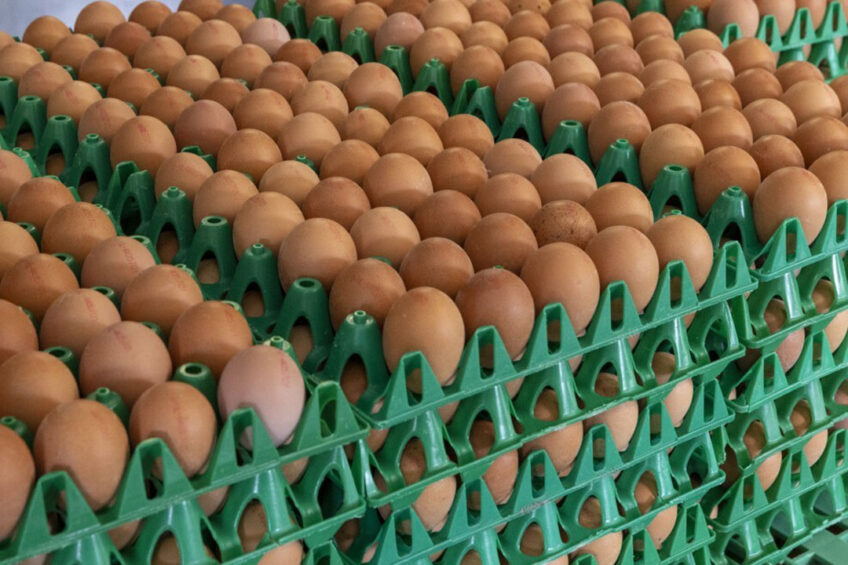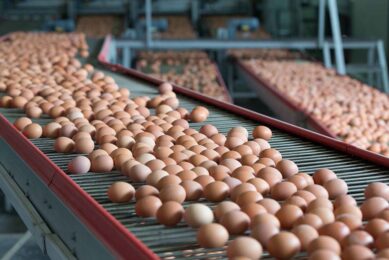Understanding the egg’s shell – top tips

Shell defects are often considered a financial loss, with consumers wanting a uniform, aesthetically pleasing egg. But the shell should be seen as a window to the flock’s health, management and productivity.
A sudden or early increase in seconds (or second-grade eggs) should always be considered a significant issue, and the type of second can help enable the farmer to identify and address issues before they have further implications on production and hen welfare.
Kathryn Stewart, poultry specialist vet at St David’s Poultry, said there were several ways to ensure a healthy shell with a positive energy balance:
- Nutrition – The shell largely consists of calcium carbonate and takes 20 of the 25 hours to produce 1 egg. Up to half of dietary calcium is needed for shell production, with additional coming from bone storage when required, although this should be prevented where possible. Birds with a negative energy balance due to poor feathering, red mite infestations, poor intestinal health or oversized eggs, or where the diet is deficient in calcium, vitamin D3 and phosphorus, will need more support to prevent thinner shells.
- Heat stress – This can affect calcium absorption due to metabolic pathways in the bird, especially when panting. In the UK, which had a particularly hot summer last year, St David’s had many reports of weak shells or even shell-less eggs. In these instances, supplementation is important. Research has shown that providing this through feed or water will improve production, FCR, hormone and immune function, egg mass, and shell quality.
- Quantity of food – A good proportion of the shell is formed during the night, so it is important that the bird has eaten enough to ensure food is available within the intestine before the lights are turned off. Physical disturbances, such as heavy red mite infestations or mucking out, can significantly interrupt rest periods and cause shell deformity.
- Packing issues – Packing machinery can also exacerbate hairline cracks and shell damage. Efforts should be made to make transitions as smooth as possible and keep belts moving consistently rather than stopping and starting. Mechanical eggs can be useful for checking for risk areas.
Stewart said that as a vet, the eggs are an important diagnostic aid before hens are even scrutinised: “For example, we get clients calling to say they have more pale eggs. The colour is mostly genetically determined, but an increase in “pale” eggs in brown hens can be attributed to infectious bronchitis, poor gut health, medication, nutrition, age, parasites or stress. Shell pimples and “sandpaper” shells can also be caused by infectious bronchitis due to damage to the oviduct.”
Certain vital and bacterial diseases can cause typical seconds. Certain infectious bronchitis strains commonly cause crinkled shells and other pale eggs. Newcastle disease can cause pointy or misshapen eggs, and Mycoplasma synoviae typically causes translucency. Egg Drop Syndrome can also lead to pale, misshapen and weak eggs but comes alongside a significant production drop.
Dirty eggs and blood on eggs
With washing eggs prohibited, normal but dirty eggs can’t be sold as first-grade eggs, which can lead to financial losses. Preventing system and floor eggs is a given for preventing shell contamination, but most of this stems from managing nest boxes, system use and litter in corners where birds are very early in lay. In this case, Stewart said producers should remove eggs frequently and promptly.
Dirty eggs can also be seen when the intestinal health is sub-optimal – if faeces are loose, this can stain the egg when laid or make nest boxes dirty. Gut health can easily be challenged in laying hens due to the short and efficient digestive tract and high demands on the birds to produce each egg. She said the hens might have a worm challenge, but the gut microbiome can be impacted by dirty water, inappropriate ventilation, temperature, disease, worms, feed management, stress, and general immunosuppression.
Poor water quality hygiene is a very common problem, so farmers should frequently test the water and ensure correct sanitation. Blood on the eggs usually indicates either a significant red mite infestation, injurious pecking or prolapse/damage to the oviduct due to large eggs.
Stewart said vaccines were available to deal with infectious bronchitis symptoms, worms and red mites.
Join 31,000+ subscribers
Subscribe to our newsletter to stay updated about all the need-to-know content in the poultry sector, three times a week. Beheer
Beheer








 WP Admin
WP Admin  Bewerk bericht
Bewerk bericht